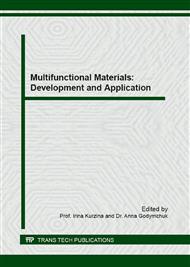[1]
NIOSH. National Institute for Occupational Safety and Health; 2011. Current Intelligence Bulletin 63: Occupational Exposure to Titanium Dioxide. Publication Number 2011-160. http: /www. cdc. gov/niosh/docs/2011-160.
DOI: 10.26616/nioshpub2011160
Google Scholar
[2]
H. Shi, R. Magaye, V. Castranova, J. Zhao, Titanium dioxide nanoparticles: a review of current toxicological data, Part. Fibre Toxicol. 6 (2013) 15.
DOI: 10.1186/1743-8977-10-15
Google Scholar
[3]
Y. Duan, J. Liu, L. Ma, Toxicological characteristics of nanoparticulate anatase titanium dioxide in mice, Biomaterials. 5 (2010) 894–899.
DOI: 10.1016/j.biomaterials.2009.10.003
Google Scholar
[4]
A. E. Nel, T. Xia, L. Madler, and N. Li, Toxic potential of materials at the nanolevel, Science. 5761 (2006) 622–627.
DOI: 10.1126/science.1114397
Google Scholar
[5]
I. Iavicoli, V. Leso, A. Bergamaschi, Toxicological Effects of Titanium Dioxide Nanoparticles: A Review of In Vivo Studies, J. Nanomat., (2012) Article ID 964381, 36 pages.
DOI: 10.1155/2012/964381
Google Scholar
[6]
M. Ortlieb, White Giant or White Dwarf? Particle Size Distribution Measurements of TiO2, GIT Lab. J. Eur. 14 (2010) 42–43.
Google Scholar
[7]
N. Sadrieh, A. M. Wokovich, N. V. Gopee, Lack of significant dermal penetration of titanium dioxide from sunscreen formulations containing nano- and submicron-size TiO2 particles, Toxicol. Sci. 115 (2010) 156–166.
DOI: 10.1093/toxsci/kfq041
Google Scholar
[8]
P. Jania, D. McCarthya, A.T. Florence, Titanium dioxide particle uptake from the rat GI tract and translocation to systemic organs after oral administration, Int. J. Pharm. 105 (1994) 157–168.
DOI: 10.1016/0378-5173(94)90461-8
Google Scholar
[9]
A. Weir, P. Westerhoff, L. Fabricius, K. Hristovski, N. von Goetz, Titanium dioxide nanoparticles in food and personal care products, Environ. Sci. Technol. 46 (2012) 2242–2250.
DOI: 10.1021/es204168d
Google Scholar
[10]
J. Wang, G. Zhou, C. Chen, H. Yu, T. Wang, Y. Ma, G. Jia, Y. Gao, B. Li, J. Sun, Acute toxicity and biodistribution of different sized titanium dioxide particles in mice after oral administration, Toxicol. Lett. (168) 2007 176–185.
DOI: 10.1016/j.toxlet.2006.12.001
Google Scholar
[11]
Q. Bu, G. Yan, P. Deng, F. Peng, H. Lin, Y. Xu, Z. Cao, T. Zhou, A. Xue, Y. Wang, NMR-based metabonomic study of the sub-acute toxicity of titanium dioxide nanoparticles in rats after oral administration, Nanotechnology. 21 (2010) 125105.
DOI: 10.1088/0957-4484/21/12/125105
Google Scholar
[12]
R. Hu, X. Gong, Y. Duan, N. Li, Y. Che, Y. Cui, M. Zhou, C. Liu, H. Wang, F. Hong, Neurotoxicological effects and the impairment of spatial recognition memory in mice caused by exposure to TiO2 nanoparticles, Biomaterials. 31 (2010) 8043–8050.
DOI: 10.1016/j.biomaterials.2010.07.011
Google Scholar
[13]
V.A. Grigorieva, O.B. Zayeva, N.A. Krivova, Comparative Study of the Biological Efficacy of Tita-nium Dioxide Nano- and Microparticles, Adv. Mat. Res. 1085 (2015) 357-362.
DOI: 10.4028/www.scientific.net/amr.1085.357
Google Scholar
[14]
M.C. Lomer, R.P. Thompson, J.J. Powell, Fine and ultrafine particles of the diet: influence on the mucosal immune response and association with Crohn's disease, Proc. Nutr. Soc. 61(1) (2002) 123-130.
DOI: 10.1079/pns2001134
Google Scholar
[15]
H. Sinnecker, T. Krause, S. Koelling, I. Lautenschläger, A. Frey, The gut wall provides an effective barrier against nanoparticle uptake. Beilstein J Nanotechnol. 5 (2014) 2092-2101.
DOI: 10.3762/bjnano.5.218
Google Scholar
[16]
Ch. Muller, T.K.Y. Lee and M.A. Montaño, Improved Chemiluminescence Assay for Measuring Antioxidant Capacity of Seminal Plasma, in: L. Barnard, K. I. Aston (Eds), Spermatogenesis : Methods and Protocols, Humana Press, New York, 2012, p. pp.363-376.
DOI: 10.1007/978-1-62703-038-0_31
Google Scholar
[17]
W. Hoffmann, Regeneration of the gastric mucosa and its glands from stem cells, Curr Med Chem. 15(29) (2008) 3133-3144.
DOI: 10.2174/092986708786848587
Google Scholar
[18]
A. Melekoğlu, T. Güven and H. Türker, Ultrastructural Effects of Titanium Dioxide on Epithelial Cells of Small Intestine of Mice, Int. Res. J. Biological Sci. 2(6) (2013) 1-7.
Google Scholar
[19]
M.C. Botelho, C. Costa, S. Silva, S. Costa, A. Dhawan, P.A. Oliveira, J.P. Teixeira, Effects of titanium dioxide nanoparticles in human gastric epithelial cells in vitro, Biomed. Pharmacother. 68(1) (2014) 59-64.
DOI: 10.1016/j.biopha.2013.08.006
Google Scholar
[20]
R.K. Shukla, A. Kumar, A.K. Pandey, S.S. Singh, A. Dhawan, Titanium dioxide nanoparticles induce oxidative stress-mediated apoptosis in human keratinocyte cells, J. Biomed. Nanotechnol. 7 (2011) 100–101.
DOI: 10.1166/jbn.2011.1221
Google Scholar
[21]
J.R. Gurr, A.S. Wang, C.H. Chen, K.Y. Jan, Ultrafine titanium dioxide particles in the absence of photoactivation can induce oxidative damage to human bronchial epithelial cells, Toxicology. 213 (2005) 66–73.
DOI: 10.1016/j.tox.2005.05.007
Google Scholar
[22]
M. Geiser, B. Rothen-Rutishauser, N. Kapp, Ultrafine particles cross cellular membranes by nonphagocytic mechanisms in lungs and in cultured cells, Envir. Health Persp. 113(11) (2005) 1555–1560.
DOI: 10.1289/ehp.8006
Google Scholar
[23]
C. Mühlfeld, M. Geiser, N. Kapp, P. Gehr, and B. Rothen-Rutishauser, Re-evaluation of pulmonary titanium dioxide nanoparticle distribution using the relative deposition index,: evidence for clearance through microvasculature, Part. Fibre Toxicology. 4 (2007).
DOI: 10.1186/1743-8977-4-7
Google Scholar
[24]
R.A. Cone, Barrier properties of mucus, Adv. Drug Deliv. Rev. 61(2) (2009) 75-85.
Google Scholar
[25]
T. Uchino, H. Tokunaga, M. Ando, H. Utsumi, Quantitative determination of OH radical generation and its cytotoxicity induced by TiO(2)-UVA treatment, Toxicol. in Vitro. 16 (2002) 629–635.
DOI: 10.1016/s0887-2333(02)00041-3
Google Scholar
[26]
J. Wang, N. Li, L. Zheng, S. Wang, Y. Wang, X. Zhao, Y. Duan, Y. Cui, M. Zhou, J. Cai, P38-Nrf-2 signaling pathway of oxidative stress in mice caused by nanoparticulate TiO2, Biol. Trace Elem. Res. 140 (2011) 186–197.
DOI: 10.1007/s12011-010-8687-0
Google Scholar
[27]
J.E. Fishman, G. Levy, V. Alli, S. Sheth, Q. Lu, E.A. Deitch, Oxidative modification of the intestinal mucus layer is a critical but unrecognized component of trauma hemorrhagic shock-induced gut barrier failure, Am. J. Physiol. Gastrointest. Liver Physiol. 304(1) (2013).
DOI: 10.1152/ajpgi.00170.2012
Google Scholar
[28]
I.A. Brownlee, J. Knight, P.W. Dettmar, J.P. Pearson, Action of reactive oxygen species on colonic mucus secretions, Free Radic. Biol. Med. 43(5) (2007) 800-808.
DOI: 10.1016/j.freeradbiomed.2007.05.023
Google Scholar
[29]
C.E. Cross, B. Halliwell, A. Allen, Antioxidant Protection: A Function of Tracheobronchial and Gastrointestinal Mucus, Lancet. 323 (8390) (1984) 1328–1330.
DOI: 10.1016/s0140-6736(84)91822-1
Google Scholar
[30]
H. Selye, Stress and disease, Science. 122 (1955) 625–631.
Google Scholar


